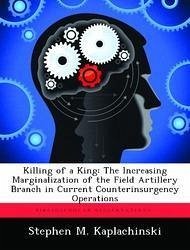
We Can Not Take Your Call for Fire Right Now - Does the Global War on Terrorism Signal the Demise of the Field Artillery?
Versandkostenfrei!
Versandfertig in über 4 Wochen
15,99 €
inkl. MwSt.

PAYBACK Punkte
8 °P sammeln!
The United States Army began transformation to meet the needs of the Global War on Terrorism (GWOT). Senior leaders within the military initiated the transformation from a division-based organization to one built around brigades. This transformation initiative demonstrated that change could be rapid. For some in the Field Artillery (FA), the concern was the change was too rapid and reduced the artillery available to support maneuver units. To make the necessary changes to support a Modular, brigade-based Army, the Army embraced Joint interdependence. Army and Joint doctrine has evolved to meet...
The United States Army began transformation to meet the needs of the Global War on Terrorism (GWOT). Senior leaders within the military initiated the transformation from a division-based organization to one built around brigades. This transformation initiative demonstrated that change could be rapid. For some in the Field Artillery (FA), the concern was the change was too rapid and reduced the artillery available to support maneuver units. To make the necessary changes to support a Modular, brigade-based Army, the Army embraced Joint interdependence. Army and Joint doctrine has evolved to meet the needs of interdependence. The primary research question for this monograph is: "does the reduction of FA batteries within a heavy brigade combat team (HBCT) reduce the effectiveness of fire support for full spectrum operations?" The literature used for this research included documents on national strategy, speeches, service and Joint publications, and military journals. These resources provided a background on what the Army expects of the Modular Fires battalion. The publications also provided an understanding of the threat the United States is facing today and the threats expected in the future. This work has been selected by scholars as being culturally important, and is part of the knowledge base of civilization as we know it. This work was reproduced from the original artifact, and remains as true to the original work as possible. Therefore, you will see the original copyright references, library stamps (as most of these works have been housed in our most important libraries around the world), and other notations in the work. This work is in the public domain in the United States of America, and possibly other nations. Within the United States, you may freely copy and distribute this work, as no entity (individual or corporate) has a copyright on the body of the work. As a reproduction of a historical artifact, this work may contain missing or blurred pages, poor pictures, errant marks, etc. Scholars believe, and we concur, that this work is important enough to be preserved, reproduced, and made generally available to the public. We appreciate your support of the preservation process, and thank you for being an important part of keeping this knowledge alive and relevant.












